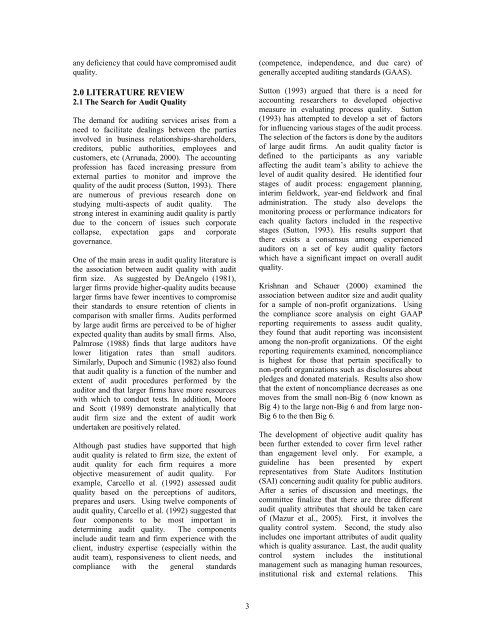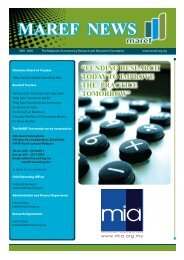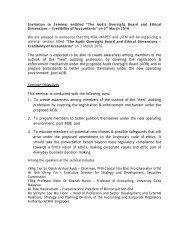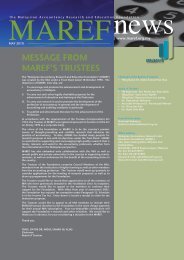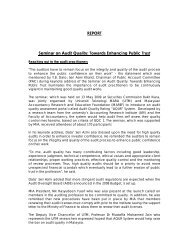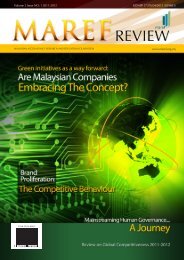Audit Quality Control: Development of Self-Assessment - Malaysian ...
Audit Quality Control: Development of Self-Assessment - Malaysian ...
Audit Quality Control: Development of Self-Assessment - Malaysian ...
Create successful ePaper yourself
Turn your PDF publications into a flip-book with our unique Google optimized e-Paper software.
any deficiency that could have compromised auditquality.2.0 LITERATURE REVIEW2.1 The Search for <strong>Audit</strong> <strong>Quality</strong>The demand for auditing services arises from aneed to facilitate dealings between the partiesinvolved in business relationships-shareholders,creditors, public authorities, employees andcustomers, etc (Arrunada, 2000). The accountingpr<strong>of</strong>ession has faced increasing pressure fromexternal parties to monitor and improve thequality <strong>of</strong> the audit process (Sutton, 1993). Thereare numerous <strong>of</strong> previous research done onstudying multi-aspects <strong>of</strong> audit quality. Thestrong interest in examining audit quality is partlydue to the concern <strong>of</strong> issues such corporatecollapse, expectation gaps and corporategovernance.One <strong>of</strong> the main areas in audit quality literature isthe association between audit quality with auditfirm size. As suggested by DeAngelo (1981),larger firms provide higher-quality audits becauselarger firms have fewer incentives to compromisetheir standards to ensure retention <strong>of</strong> clients incomparison with smaller firms. <strong>Audit</strong>s performedby large audit firms are perceived to be <strong>of</strong> higherexpected quality than audits by small firms. Also,Palmrose (1988) finds that large auditors havelower litigation rates than small auditors.Similarly, Dupoch and Simunic (1982) also foundthat audit quality is a function <strong>of</strong> the number andextent <strong>of</strong> audit procedures performed by theauditor and that larger firms have more resourceswith which to conduct tests. In addition, Mooreand Scott (1989) demonstrate analytically thataudit firm size and the extent <strong>of</strong> audit workundertaken are positively related.Although past studies have supported that highaudit quality is related to firm size, the extent <strong>of</strong>audit quality for each firm requires a moreobjective measurement <strong>of</strong> audit quality. Forexample, Carcello et al. (1992) assessed auditquality based on the perceptions <strong>of</strong> auditors,prepares and users. Using twelve components <strong>of</strong>audit quality, Carcello et al. (1992) suggested thatfour components to be most important indetermining audit quality. The componentsinclude audit team and firm experience with theclient, industry expertise (especially within theaudit team), responsiveness to client needs, andcompliance with the general standards(competence, independence, and due care) <strong>of</strong>generally accepted auditing standards (GAAS).Sutton (1993) argued that there is a need foraccounting researchers to developed objectivemeasure in evaluating process quality. Sutton(1993) has attempted to develop a set <strong>of</strong> factorsfor influencing various stages <strong>of</strong> the audit process.The selection <strong>of</strong> the factors is done by the auditors<strong>of</strong> large audit firms. An audit quality factor isdefined to the participants as any variableaffecting the audit team’s ability to achieve thelevel <strong>of</strong> audit quality desired. He identified fourstages <strong>of</strong> audit process: engagement planning,interim fieldwork, year-end fieldwork and finaladministration. The study also develops themonitoring process or performance indicators foreach quality factors included in the respectivestages (Sutton, 1993). His results support thatthere exists a consensus among experiencedauditors on a set <strong>of</strong> key audit quality factorswhich have a significant impact on overall auditquality.Krishnan and Schauer (2000) examined theassociation between auditor size and audit qualityfor a sample <strong>of</strong> non-pr<strong>of</strong>it organizations. Usingthe compliance score analysis on eight GAAPreporting requirements to assess audit quality,they found that audit reporting was inconsistentamong the non-pr<strong>of</strong>it organizations. Of the eightreporting requirements examined, noncomplianceis highest for those that pertain specifically tonon-pr<strong>of</strong>it organizations such as disclosures aboutpledges and donated materials. Results also showthat the extent <strong>of</strong> noncompliance decreases as onemoves from the small non-Big 6 (now known asBig 4) to the large non-Big 6 and from large non-Big 6 to the then Big 6.The development <strong>of</strong> objective audit quality hasbeen further extended to cover firm level ratherthan engagement level only. For example, aguideline has been presented by expertrepresentatives from State <strong>Audit</strong>ors Institution(SAI) concerning audit quality for public auditors.After a series <strong>of</strong> discussion and meetings, thecommittee finalize that there are three differentaudit quality attributes that should be taken care<strong>of</strong> (Mazur et al., 2005). First, it involves thequality control system. Second, the study alsoincludes one important attributes <strong>of</strong> audit qualitywhich is quality assurance. Last, the audit qualitycontrol system includes the institutionalmanagement such as managing human resources,institutional risk and external relations. This3


